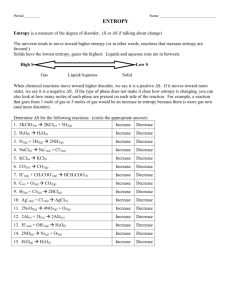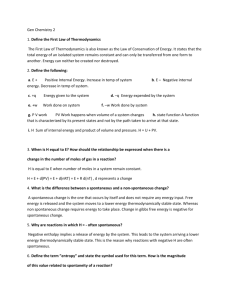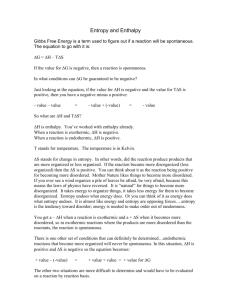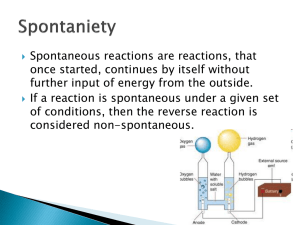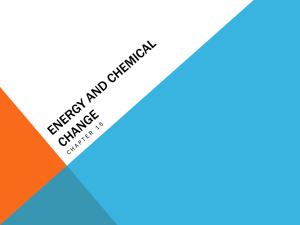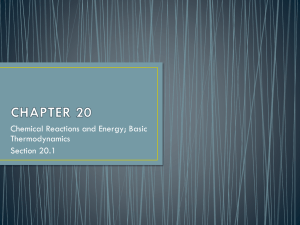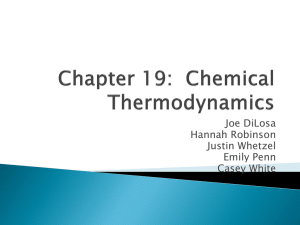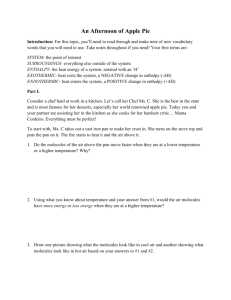Spontaneous reactions
advertisement
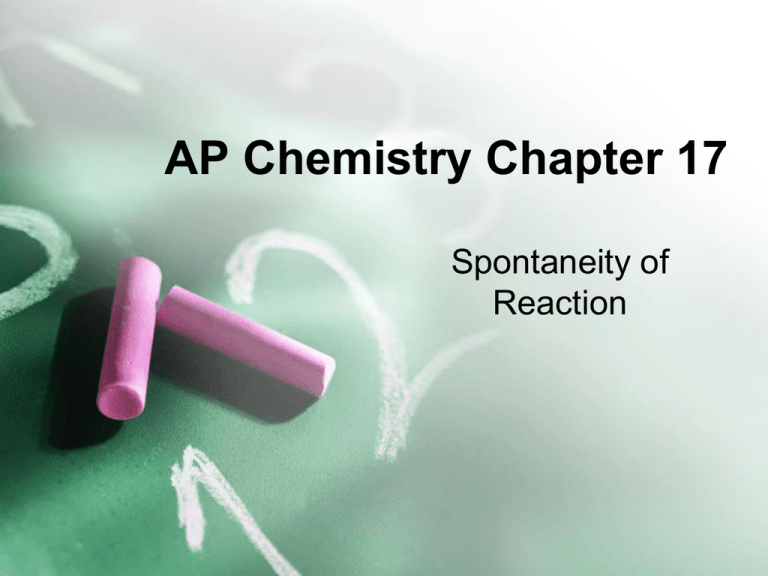
AP Chemistry Chapter 17 Spontaneity of Reaction Spontaneous reactions What does that mean? Some occur without any “help” Others require some “help” No help – ice cube melting Help – wood burning • If a reaction is spontaneous under a certain set of conditions, the reverse reaction must be nonspontaneous • In any spontaneous change, the amount of free energy available decreases toward zero as the process proceeds towards equilibrium. Reactions tend to be spontaneous when: • it leads to lower energy = -∆H • But not always!!!! • Also tend to be spontaneous if the reaction results in an increase in randomness • Entropy S • Greater entropy – more random the system is. +∆S increase in entropy ∆S>0 • - ∆S decrease in entropy ∆S<0 • Page 448 Example 17.1 Predict sign of ∆S • In general, nature tends to move spontaneously from more ordered to more random state (less ordered) • Entropy increases in the order: • s <l < g • g>l>s • Increasing temperature of a substance increases its entropy Third Law of Thermodynamics • A completely ordered pure crystalline solid has an entropy of zero at 0K ∆S for reactions • Pg. 450 Table of Standard Entropies • Used to calculate the standard entropy change, ∆So, for reactions. • ∆So = ∑ So products – ∑So reactants • Must remember to multiply by the number of moles from balanced equation • Note that So is a positive quantity for both compounds and elements; can be negative for ions in solutions • Reactions which So is positive tend to be spontaneous, at least at high temperatures. • H2O(s) H2O(l) ( ∆S > 0) • H2O(l) H2O(g) (∆S > 0) • Fe2O3(s) + 3H2(g) 2Fe(s) + 3H2O(g) (∆S > 0) • All of these reactions are endothermic (∆H>0) • They become spontaneous at high temperatures A reaction that results in an increase in the number of moles of gas is accompanied by an increase in entropy. If the number of moles of gas decreases, ∆S is a negative quantity Elements have nonzero standard entropies Standard molar entropies of pure substances are always positive quantities Aqueous ions may have negative So values Among substances of similar structure and physical state, entropy usually increases with molar mass Molecule becomes more complex, more ways for the atoms to move about with respect to one another (higher entropy) • Pg. 449-451 samples • Example 17.2 Second Law of Thermodynamics • In a spontaneous process, there is a net increase in entropy, taking into account both system and surroundings. • ∆Suniverse = ∆Ssystem + ∆Ssurroundings > 0 • spontaneous Gibbs Free Energy G • Two quantities affect reaction spontaneity; • enthalpy, H and entropy, S • Put them together in a way that the signs will give us a clue • G = H – TS • T = kelvin temp • ∆G – for a reaction at constant temp and pressure, represents that portion of the total energy change that is available to do useful work – is a state property • Depends only on the nature of products and reactants and the conditions (temp/pressure/concentration), not on the path by which the reaction is carried out - ∆G = spontaneous + ∆G = not spontaneous (reverse is spontaneous ∆G = 0 system is at equilibrium (no tendency for reaction to occur in either direction) ∆G measure of the driving force of a reaction • Reaction, at constant pressure and temperature, go in such a direction as to decrease the free energy of the system • Products have lower free energy, reaction will go in that direction • Reactants have lower free energy, reaction will go in that direction (means the reverse rxn spontaneous) Gibbs-Helmholtz equation ∆G = ∆H - T∆S To make ∆G negative; Negative value for ∆H (exothermic) Positive value for ∆S (less ordered) Gibbs-Helmholtz equation • Valid under all conditions but we will apply it only under “standard conditions” • Meaning: gases are at one atmosphere partial pressure • Ions or molecules in solution are at one molar concentration • ∆G = standard free energy change • ∆Go = ∆Ho - T∆So • now we can use the tables in the book • If ∆Go is negative = spontaneous at standard conditions • If ∆Go is positive = nonspontaneous at standard conditions • ∆G = 0 system is at equilibrium at standard conditions o 25 C Calculation of ∆G at Free Energies of Formation!! Make sure units are correct Use ∆H is kJ, convert ∆S for J/K to kJ/K Pg. 455 Example 17.3 Pg. 456 Example 17.4, 17.5 Pg. 458 IMPORTANT TABLE!!

